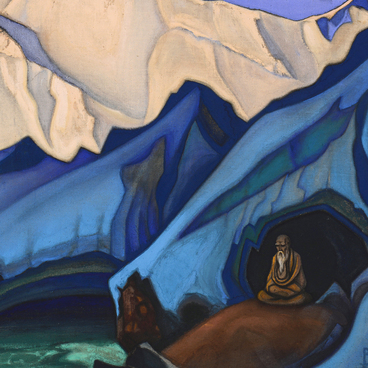In the second half of the 17th century, local cults of saints begin to emerge in Western Siberia. SimeOn of VerkhotUrye the Righteous was one among the first of such saints. The saint was born into a noble family; however, he decided to leave the wealth belonging to him by birthright and move to Siberia.
In Siberia he led a life of a simple pilgrim, hiding his descent and preaching Christianity to indigenous people. The ascetic prayed and trialed his spirit and body by standing on his knees on a stone in the dense forests of the taiga. Simeon often visited the village of Merkushino, located not far from the town of Verkhoturye. Here he prayed in the wooden church of Archangel Michael. The saint died in 1642 praying and fasting.
Later the villagers of MerkUshino miraculously obtained the incorruptible relics of the Righteous. As a result, many people were healed. Thus, Simeon was proclaimed a saint for his humility and ascetic life. Icons of him were painted in accordance with his hagiography.
Siberian icon painting researchers believe that the oldest known image of Simeon dates back to the mid-18th century. In this icon, Simeon is barefoot and wearing a red shirt. He is praying to the Saviour together with Phocas the Martyr.
With time icon painters have enriched the saint’s iconography by coming up with new interpretations of his image. He is depicted praying in the cell, with the cityscape in the background, or during the translation of the relics from Merkushino to Verkhoturye. Icons like the one from the NovosibIrsk State Art Museum collection were the most popular in the last third of the 19th century with Simeon depicted in front of a stone chapel in Merkushino. The artist depicted Simeon wearing a dark-blue inner cassock, an everyday piece of clothing worn by the clergy, with a text of the prayer in his hand. He is standing on a riverbank with a fishing rod and a bucket of water at his feet. Slightly bowing his head, Simeon is praying and God is blessing him from the skies. The scenery harmonizes with the overall serenity and tranquility.
In Siberia he led a life of a simple pilgrim, hiding his descent and preaching Christianity to indigenous people. The ascetic prayed and trialed his spirit and body by standing on his knees on a stone in the dense forests of the taiga. Simeon often visited the village of Merkushino, located not far from the town of Verkhoturye. Here he prayed in the wooden church of Archangel Michael. The saint died in 1642 praying and fasting.
Later the villagers of MerkUshino miraculously obtained the incorruptible relics of the Righteous. As a result, many people were healed. Thus, Simeon was proclaimed a saint for his humility and ascetic life. Icons of him were painted in accordance with his hagiography.
Siberian icon painting researchers believe that the oldest known image of Simeon dates back to the mid-18th century. In this icon, Simeon is barefoot and wearing a red shirt. He is praying to the Saviour together with Phocas the Martyr.
With time icon painters have enriched the saint’s iconography by coming up with new interpretations of his image. He is depicted praying in the cell, with the cityscape in the background, or during the translation of the relics from Merkushino to Verkhoturye. Icons like the one from the NovosibIrsk State Art Museum collection were the most popular in the last third of the 19th century with Simeon depicted in front of a stone chapel in Merkushino. The artist depicted Simeon wearing a dark-blue inner cassock, an everyday piece of clothing worn by the clergy, with a text of the prayer in his hand. He is standing on a riverbank with a fishing rod and a bucket of water at his feet. Slightly bowing his head, Simeon is praying and God is blessing him from the skies. The scenery harmonizes with the overall serenity and tranquility.

